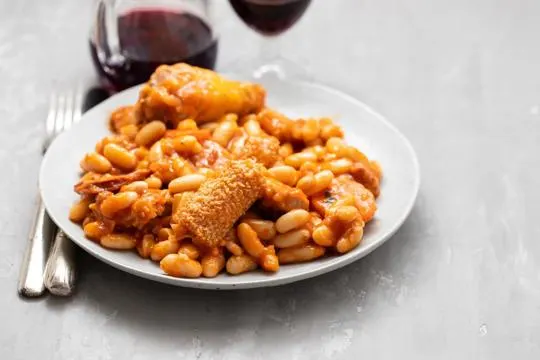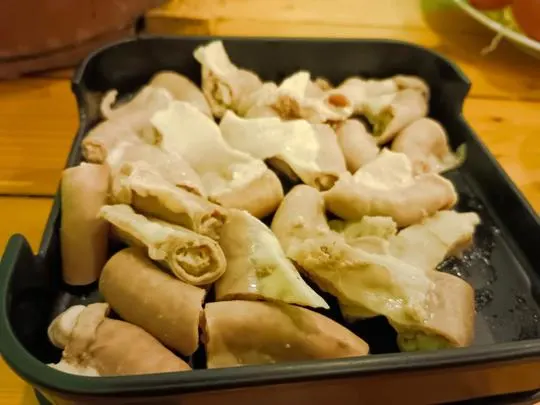Summary of key points
The main difference between chitlins and tripas is in the animal they come from and their preparation process. Chitlins, also known as chitterlings, are made from pig intestines that have been cleaned, boiled, and sometimes fried. Tripas are made from cow or sheep intestines and are often grilled or fried.
In terms of taste, both options have a distinct flavor and texture but may vary depending on the cooking method and seasonings used.
In terms of cultural significance, chitlins are commonly associated with Southern cuisine in the United States, while tripas are popular in Mexican and Latin American dishes.
Both options require thorough cleaning and careful preparation to ensure food safety.
Chitlins and tripas may sound like bands from the 70s, but they’re not.
They’re about to take center stage in our grub showdown. Both have die-hard fans swearing by their deliciousness. Yet, the uninitiated might scratch their heads. What even are they? We’ve been there, trying to figure out if we’re brave enough to dig in or should graciously pass the plate.
Chitlins, friends, are cleaned pig intestines, often slow-cooked to perfection. Tripas, on the flip side, hail from the cow’s belly — think tacos but more adventurous.
Ever had that moment at a family gathering where you’re handed a dish you can’t identify? That was us with chitlins and tripas. Now, we’re here to share all we’ve learned. It’s a ride, we promise.
What are Chitlins?

Chitlins, also known as chitterlings, are a Southern delicacy.
They are made from the small intestines of pigs.
Traditionally cooked slowly until tender, they have a distinct flavor and texture.
This tasty treat has been around for centuries.
It originated in African cuisine during the era of slavery in the U.S. Slaves were given unwanted parts of animals, like pig intestines, making chitlins a staple food.
To prepare chitlins, they must be cleaned carefully.
This is time-consuming and requires attention to detail.
Then they are simmered or fried with seasonings like onion, garlic, and spices.
Chitlins have a similar counterpart called tripas.
They are made from the intestines of cows or sheep.
Both dishes require similar preparation and have loyal fans.
However, they differ in taste and texture. Chitlins are rich and fatty.
Tripas have a milder flavor and a chewy texture.
Some describe it as having a slight gamey taste.
What are Tripas?

Tripas are a yummy delicacy with a long history.
You can find them in a variety of cuisines from Mexico to Portugal.
They are made from the small intestines of critters such as cows or pigs, and they have a taste and texture that makes them stand out.
The way they are prepared makes them one-of-a-kind.
After being cleaned and boiled in flavor-packed spices, tripas are usually grilled or fried until they are crisp on the outside and tender on the inside.
This blend of textures is why they are so popular.
Tripas’ flavors vary based on the culture.
In Mexican cuisine, for example, they are typically seasoned with garlic, onion, and chili powder.
Enjoy them on their own or fill tacos or sandwiches with them.
Chitlins are unlike tripas, despite some similarities.
Chitlins come from large intestines and have a different flavor profile.
They require more thorough cleaning before cooking, since they tend to be smelly.
If you come across tripas or chitlins on a menu, go for it.
It’s a chance to try something special and scrumptious.
It also shows the creativity and resourcefulness of cooks around the world.
Differences Between Chitlins and Tripas

Chitlins and tripas may look the same, but they have big differences.
Chitlins are pig intestines, while tripas are cow or sheep intestines.
1 – Source and Origin
Chitlins and Tripas may seem the same, but have distinct sources.
Chitlins, also known as chitterlings, are an African-American delicacy made from pigs’ small intestines.
Conversely, Tripas are Mexican dishes prepared from cows’ or sheep’s small intestines.
Chitlins originate from African cuisine, particularly West Africa.
Enslaved Africans brought this custom to the Americas during the transatlantic slave trade.
It later became common with African-Americans in the south of the U.S. Tripas come from Mexico’s gastronomic history.
Mexican cooking often uses different animal parts to create scrumptious dishes.
In Mexico, Tripas are usually served as tacos or in various savory dishes.
Though both chitlins and tripas are made from animal intestines, their cultural backgrounds and cooking methods make them unique.
These culinary delights show the richness of global cuisine and how cultures use ingredients to create one-of-a-kind flavors.
2 – Preparation Method
Chitlins and Tripas have different prep methods.
Chitlins, also known as chitterlings, come from pigs’ small intestines while Tripas come from cows’ or sheep’s intestines.
Chitlins must be cleaned with water and boiled for several hours to remove any bacteria and odor.
This is necessary because small intestines can carry waste.
For Tripas, they’re usually soaked in a salt-vinegar-water mix first to get rid of the smell, then washed and simmered/boiled until tender.
The slow cooking helps soften the intestines.
Chitlins have a unique aroma that not everyone likes, but some find it delightful.
This difference in opinion makes cuisine preferences diverse.
3 – Flavor and Texture
Flavor and texture are key when it comes to chitlins and tripas.
Chitlins have a earthy flavor and a chewy yet tender texture.
Meanwhile, tripas have a strong flavor.
The outside is slightly crispy and the inside is soft and succulent.
These differences show the distinct taste experiences they offer and how they stand out in the culinary world.
4 – Culinary Uses
Chitlins and tripas have unique flavors and textures, great for many dishes.
Chitlins have a hearty taste and are usually fried or boiled and served with onions and spices.
They can also be added to soups or stews.
Tripas are often used in Mexican cuisine.
They are cooked until crispy and used in tacos or burritos for a crunchy texture.
Both chitlins and tripas offer delicious possibilities in the kitchen that will tantalize your taste buds.
Similarities Between Chitlins and Tripas

Chitlins and tripas have some surprising similarities, despite their cultural differences.
Both are made from the intestines of animals – pigs for chitlins and cows for tripas.
These organs need to be cleaned and prepared before cooking.
Boiling or frying them until tender and flavorful is the process.
Taste and texture may differ, but their shared origins as offal dishes make them an intriguing choice for foodies.
Including these culinary experiences in one’s adventures allows for a deeper appreciation of cultures around the world.
Moreover, they both are regarded as traditional dishes in many communities.
They are often enjoyed during special occasions, emphasizing their importance in respective cultures.
Food is a unifying force, connecting people through shared culinary experiences.
Chitlins and tripas also offer unique flavors.
Chitlins have a rich, savory taste, while tripas boast a milder flavor profile.
Spices and seasonings further enhance their tastes.
This showcases the creativity and ingenuity within different cuisines.
In summary, despite their cultural backgrounds, chitlins and tripas have more similarities than meets the eye.
Their shared origins as offal dishes highlight their cultural significance, while providing unique flavors that captivate food lovers.
Exploring these gustatory delights not only offers a delightful dining experience, but also invites individuals to embrace diversity by connecting with different traditions through food exploration.
Cultural Significance of Chitlins and Tripas
Chitlins and Tripas are significant in culture.
Chitlins represent resilience and African-American heritage.
On the other hand, Tripas are linked to Latin American cuisine.
They showcase diverse flavors and preserve cultural identity.
Chitlins are made from hog intestines.
They have been eaten by African-Americans for generations.
The laborious preparation reflects dedication to the cuisine.
Tripas are from farm animals’ small intestines.
They need thorough cleaning before cooking.
In Latin American cultures, they symbolize resourcefulness and sustainability.
Although both come from animal intestines, chitlins and tripas differ in flavor and texture.
Chitlins are spiced with garlic, onions and pepper.
They have an earthy taste, depending on the region.
Tripas are marinated with herbs and spices like cilantro and cumin.
They have an aromatic flavor and a tender, succulent texture.
Health Considerations
Health comes first when it comes to food.
For chitlins and tripas, understanding the health implications is key.
Chitlins, or pig intestines, must be prepared properly to remove bacteria and parasites.
Tripas, or cow and pig small intestines, on the other hand, must be cleaned thoroughly before cooking.
High temperatures should be used when cooking both dishes.
Hygiene and correct cooking techniques are essential for these delicacies.
Conclusion
All in all, understanding the origins and differences between chitlins and tripas can help you better meal plan for yourself.
Not only do these two dishes have practically the same unique flavor, but they are also quite economical cuts of meat due to their abundant availability and low cost, which makes them terrific choices for a variety of Get-togethers.
Chitlins are crispier and cook faster while Tripas takes longer to cook but yields a softer texture.
Both dishes pair best with rice, coleslaw or potatoes; additionally, their unique flavors allow them to be used in a huge range of recipes such as Mexican tacos, sandwiches, salads or even soups.
Whether you’re looking for ways to update a classic family recipe or trying something new with friends, both components will give your culinary creations fantastic flavor.
So the next time you’re feeling particularly adventurous in the kitchen, consider trying out both Chitlins and Tripas –who knows they could be just what you have been searching for.

Leave a comment